The most authentic Star Wars reconstruction can be seen in HD
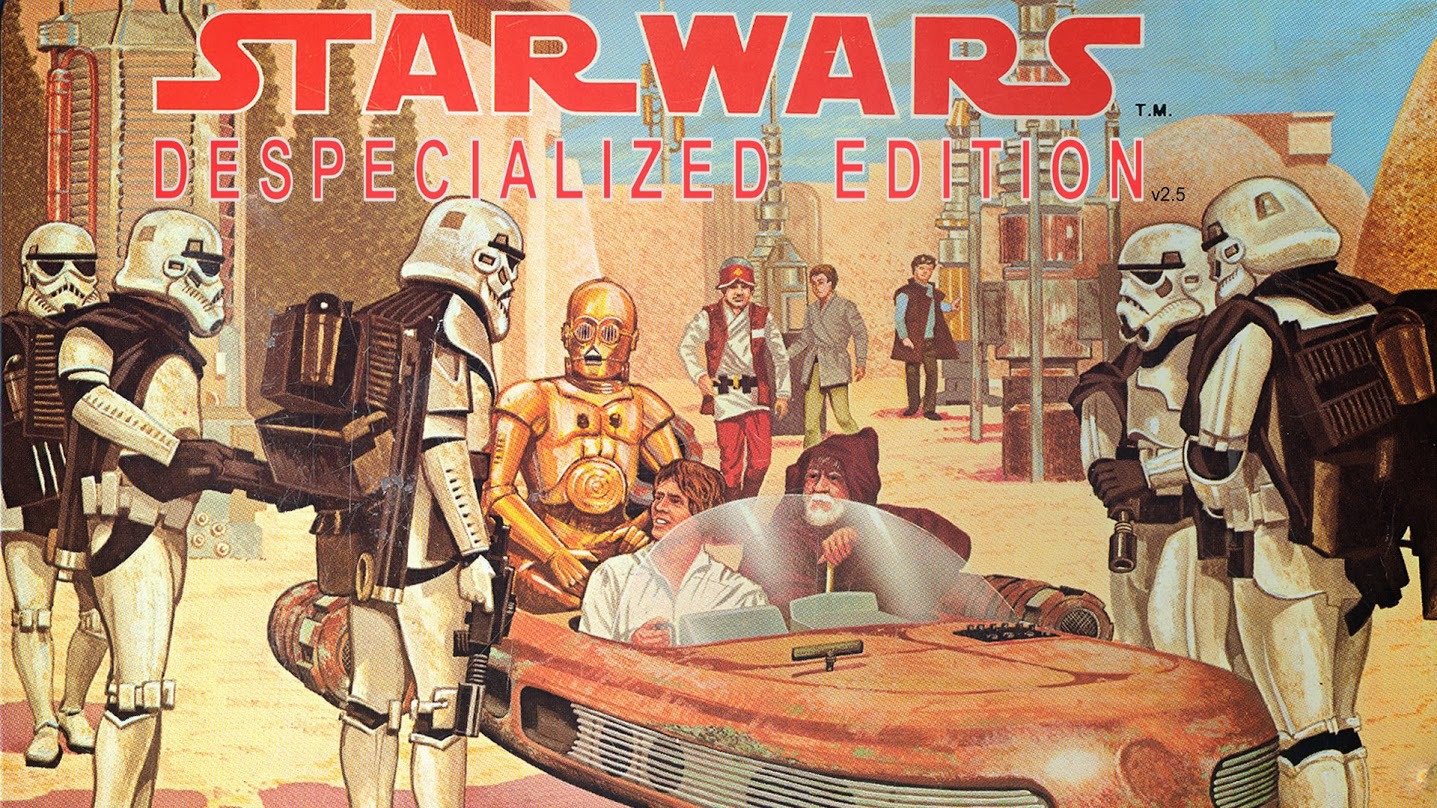
The story told in Star Wars is a classic. Every few hundred years, it is retold again, since we have a tendency to repeat what we have done. Power corrupts, and when you are at the helm, you begin to do what you think is right, although in fact this is not true.
George Lucas, an interview with Wired
. While Disney is preparing to defile the corpse of the original Star Wars trilogy once again and think seriously about a stereoscopic re-release, it's worth remembering how its creator relates to his offspring. The first three films - and this is not about three episodes that were shot much later (thanks, Lucas, for this need for clarification) - received a lot of blatantly unnecessary changes in the re-release on Blu-ray.
Lists on Wikipedia can be perceived as a statement of a certain fact or a characteristic of an object. So, the list of list of lists clearly demonstrates the vastness and orderliness of the Internet encyclopedia, and the list of Brezhnev’s awardsbetter than any article shows the vice of the late Secretary General. 60 kilobytes of just a partial textual description of the changes in the re-releases of Star Wars films illustrate perfectly the number of alterations accumulated after 1981, 1997, 2004 and 2011.
Of course, some of the changes are related to the primitiveness of the special effects technology of the era of the original trilogy, but many fans will not agree, for example, with the fact that the scene with Jabba the Hut cut from the first episode was worth returning. Lucas himself states that the original versions were only 25-30 percent of what he intended to do. But is it worth blaming the audience for the fact that they can’t put up with the growing number of new unusual changes from publication to publication?
A group of dedicated fans is working on the Star Wars Despecialized Edition project. This is a triumph of video editing and restoration techniques performed by lay people. No one specifically provided master copies, all the materials used in the project were available to the general public.
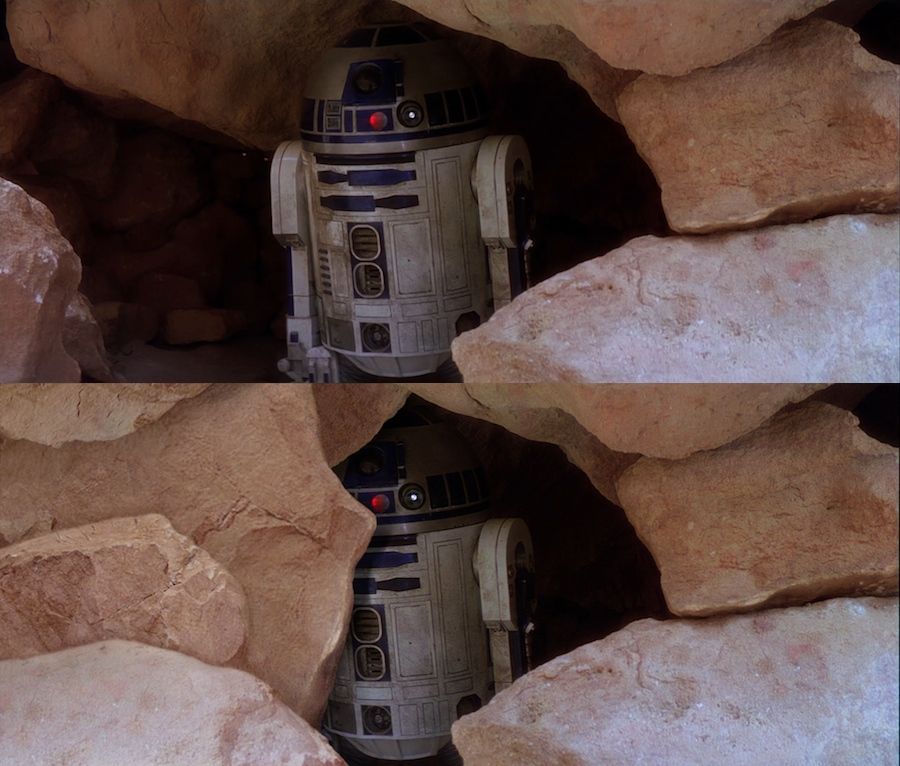
The most obvious example of the stupidity of the 2011 re-release of Blu-ray. Judging by the statements of Lucas, the lack of development of video editing technologies and special effects for 34 years prevented him from adding this additional stone. This picture has already become an Internet meme.
The Star Wars Despecialized Edition project provides an opportunity to bring the viewing experience as close as possible to the original 1977 rental in HD quality. (Most likely, 720p - not 1080p - quality was chosen so as not to make the upscale of many scenes too obvious.)
Here we will talk about a project to recreate the movie Star Wars. Episode 4: A New Hope, which in the original box was called Star Wars. The project was started by a group of participants in the OriginalTrilogy.com forum .
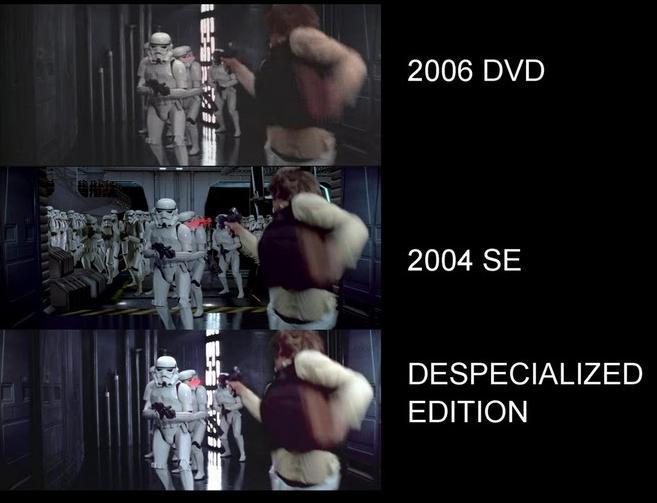
Comparison of the 2006 edition of GOUT, for some reason the added crowd of stormtroopers in the 2004 special edition, and the Despecialized Edition
There will be only one [version of each of the films]. And it will not be what I would call a preliminary installation, it will be the final installation. The rest will remain only some kind of artifact, looking at which, people will say: "And there was an earlier draft." The same thing happens with plays and early versions of books. In essence, films are never ready for good; they are only showered. At a certain stage, someone with the words “okay, ready” pulls you away from the picture while you wave your fists and scream. The situation should not be quite like that. Sometimes you can go back and create your own new version, which I did with the films "American Graffiti" and "THX 1138"; such films will remain in eternity. Therefore, the main thing for me is how the DVD version will look, since this is what everyone will remember. Other versions will disappear. Even the existing 35mm Star Wars films will not last longer than 30 or 40 years. After a hundred years, the only version that will be remembered will be the DVD version of the [special edition], and you can project it onto a standard movie screen with perfect quality. I believe that the return and renewal of the film is the privilege of the director, not the studio.
George Lucas on Special Editions , 1997
Sources
When it comes to special publications, it is worth remembering that in addition to a significant number of additions to objects, colors have also been changed. Therefore, by the way, the significantly modified edition of 2011 on Blu-ray is not the best in quality and requires serious revision. However, it is the main source of the project.
Do you know the disappointment that the 2011 edition was received from the same master copy as the 2004 DVD edition, which led to the inheritance of the same problems? The Blu-ray edition has the same black color in which many important details are drowned, and a very changed color palette. Fortunately, the bitrate and resolution of the source made it possible to correct these artifacts to a certain extent.


For the initial editing of colors, you should thank You_Too, who wrote a script for AviSynth and removed the disgusting magenta color in most scenes, especially noticeable in scenes of blaster shootings.

Also, for the correction of colors, a well-preserved film technicolor copy was used in stages.
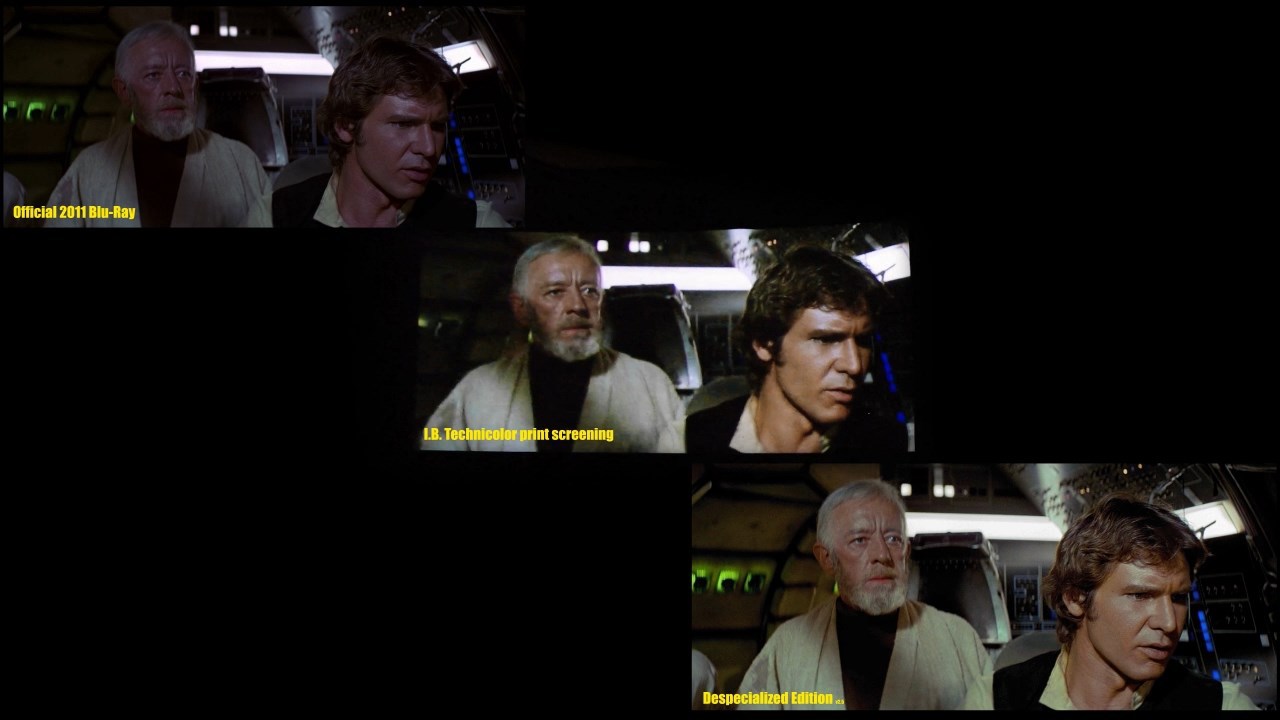
Also in the Blu-ray edition, digital cleaning was performed, so some scenes looked very, very unnatural. This problem has been partially fixed.
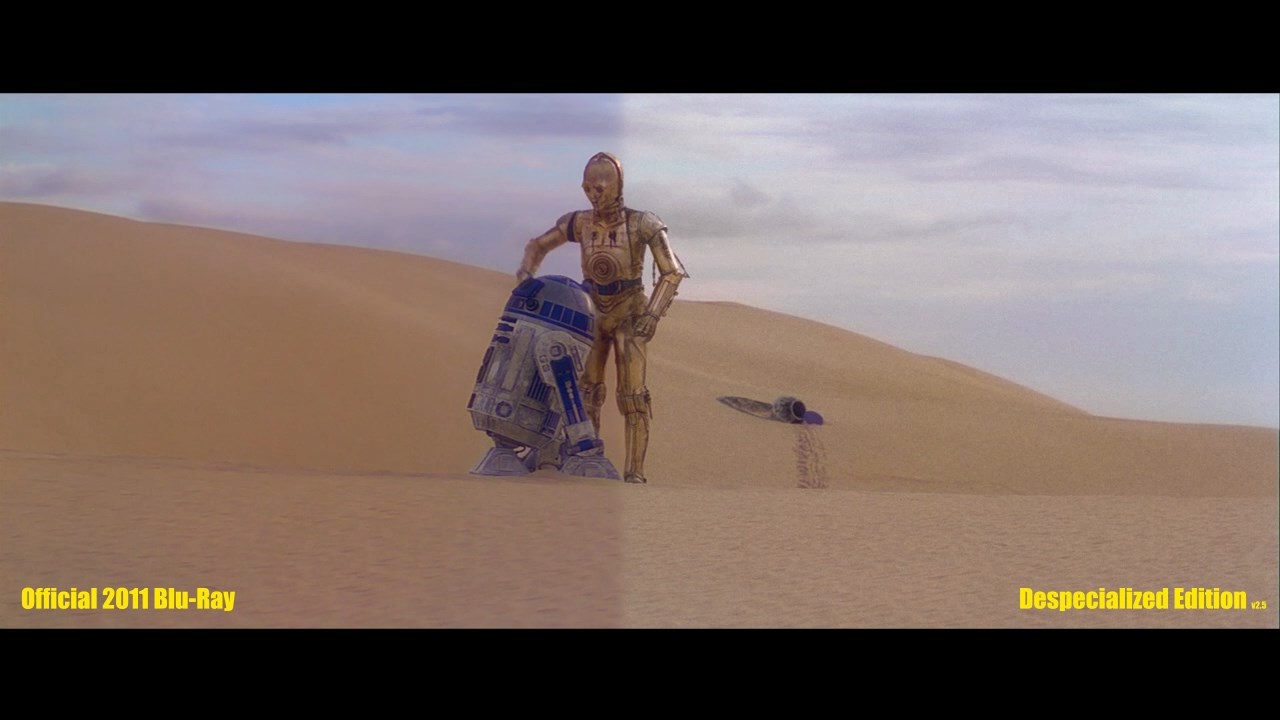
And also positive in working on a special edition was the opportunity to return and make the original Star Wars: A New Hope exactly as George wanted. So how he wrote them. It doesn’t matter if people liked it, this is his film, and he couldn’t do it the first time, because he made so many compromises.
Rick McCallum, 2001
At the moment, the official editions of the original, unchanged film Star Wars: Episode 4 - A New Hope of acceptable quality simply do not exist. There is only the 2006 DVD edition (it is widely known among fans as “George’s unchanged original trilogy”, Geoge's Original Unaltered Trilogy, shortly GOUT), the disc of which was not the main one in the publication, but went as a bonus, and its quality leaves much to be desired.
GOUT is a non-anamorphic copy of 1993, and this, unfortunately, is the best official source of the unchanged trilogy. In addition to its poor quality, terrible picture aliasing and faded color in some scenes, it has artifacts of a primitive digital noise removal algorithm: fast-moving objects leave a trace from their own image in previous frames.
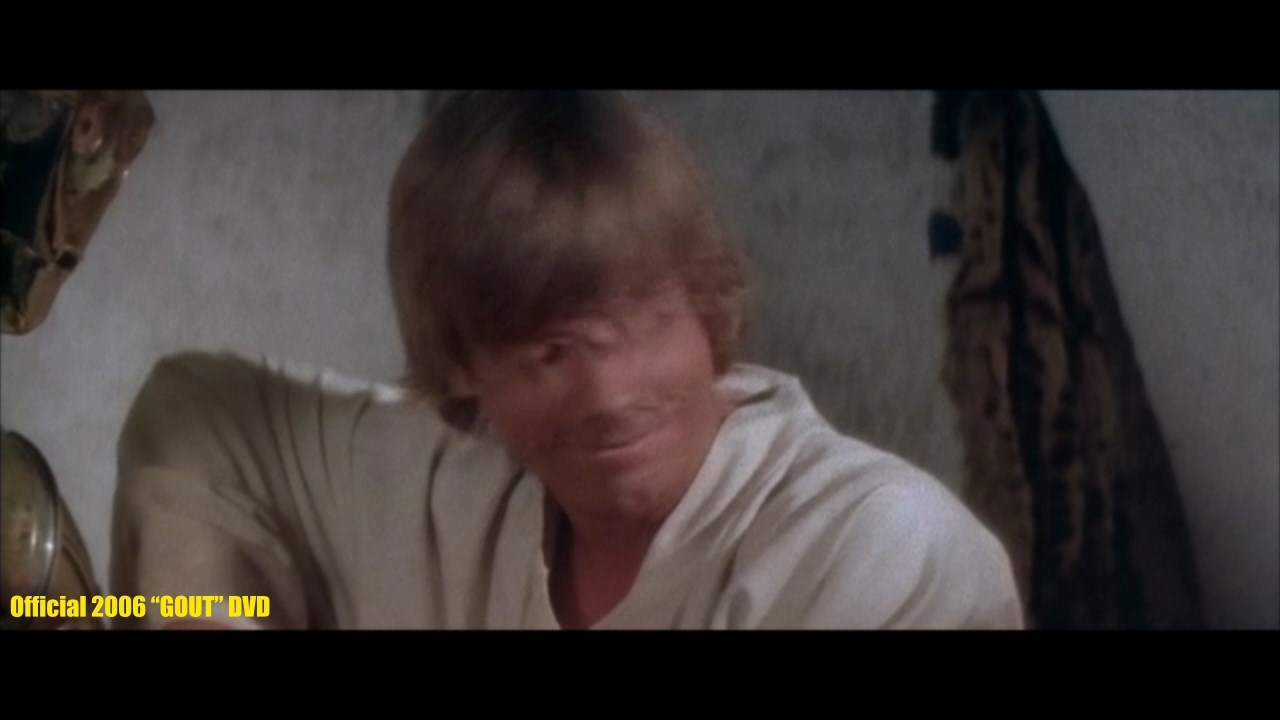
How was this impressive picture quality obtained even in altered scenes, if there was simply no other source?
Upscaling this outdated picture so that it looks acceptable nearby in HD scenes, and its color correction is not an easy task. This work was done by dark_jedi. But often only parts of the picture from GOUT were used.

The aforementioned 2004 edition on DVD was also used as a source, but for this we took not the DVD edition itself, but HD broadcast of the same master copy on television. This broadcast was the main source of the first editions of the Despecialized Edition and remains the source of some scenes of the current version.
In order to remove some of the changes in the 2004 edition, the SD PAL analog recording of the infamous first special edition of 1997 was used. We all "appreciate" the re-release in honor of the twentieth anniversary of the rental of the original, the first appearance of the computer Jabba the Hutt in The New Hope.

A self-respecting fan of the original trilogy will easily be able to stretch the grunt about this for several tens of minutes. The fact is that this scene did not appear at the box office in 1977, since it was planned to use stop motion animation to replace the understudy with a slug-like gangster, Harrison Ford circled fatty Declan Mulholland around the set. In 1977, Lucas was not satisfied with the result, and, thank God, there was no computer animation, so the scene was simply not included in the film. This made Hutt's appearance in Return of the Jedi an event. Over the past two films, we could only hear about this head of tattoo bandits from the stories of other characters, but we did not know how he looks and speaks. Now, his appearance did not cause any special impressions. By the way, the 1997 Digital Hutt and its later version look bad and unnatural.
Another reason to hate Lucas is the scene at the bar. The phrase "Khan fired first" became a symbol of disobedience of the audience to the will of the director. In the 1997 edition, technology had already allowed the scene to be changed so that Ford's hero did not shoot first, although in the original Grido had no chance to do anything. Han Solo, who calmly and without hesitation roasted the bounty hunter and threw “Sorry about the mess” at the exit, says much more about the character of a smuggler who is ready for anything than a forcedly defending character. Of course, in the Despecialized Edition, this scene is recreated in its original form.
People who modify or destroy works of art and our cultural heritage for the sake of profit [...] are barbarians [...]
George Lucas, 1988
Again, some frames of the final result carry only parts of the 1997 edition. Here was taken only part of the corridor in the background.

But some frames were replaced entirely. In the 2011 edition of Blu-ray, these inscriptions are made in imperial.

The following sources are somewhat exotic, and their appearance we owe to the occasion, as well as a healthy share of DIY. In the tenacious hands of the creators of Despecialized Edition, Team Negative1 performed at home a scan of a 35-mm film of the scene at the Mos Islay spaceport.
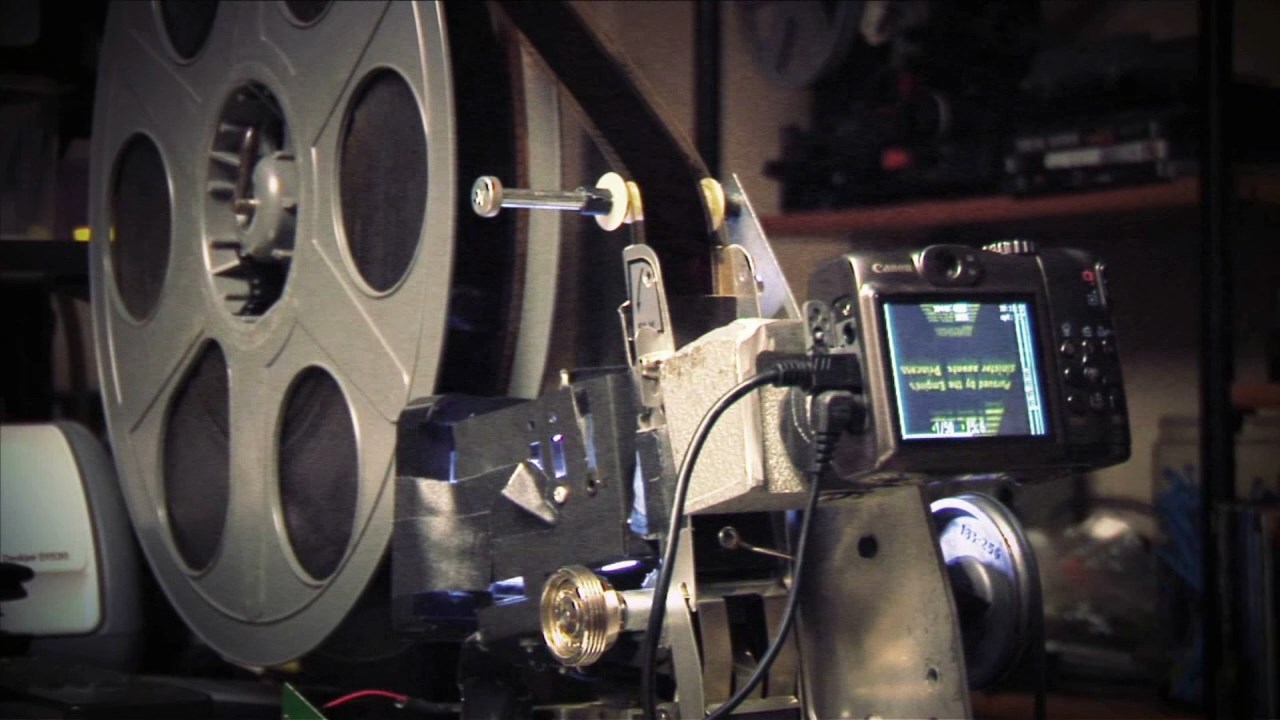
Despite the relatively good picture quality, Laserschwert had to remove a lot of dirt and grain with AviSynth to improve it. And again, to hide the additions of special publications, both whole frames and only parts of the picture were used, as shown below.

In addition, one of the auxiliary sources was a copy on a 16 mm film called Puggo Grande. The timings and location of the grids of the grids in the dialogue with Han Solo were taken from there. In this frame, it was used to minimize the aliasing of the Wing of the Crosswing / X-Wing image of GOUT.

The last source was a group of still pictures from a 35 mm film received from various sources, some of which prefer to remain anonymous. The quality of the images was also rather rough, but after digital cleaning they were used to restore scenes with the technique of matte painting and improve the quality of the picture from GOUT.

They were also used to cover changes to the 2011 edition of Blu-ray. Here, I even had to animate some movements and use rotoscoping.

On the left is the addition of the 2011 edition using computer graphics, on the right is its restored version
In this album you can find many screenshots with comparisons showing improvements in Despecialized Edition 2.5 relative to project version 1.0, GOUT (the only official edition of the unchanged movie) and Blu-ray (the maximum number of controversial changes).
A finished draft of the current version 2.5 can be found on Pirate Bay for a search query.
Star Wars Despecialized Edition mkvIn the same distribution there are Russian subtitles and several types of audio track. Do not forget about the nature of peer-to-peer networks; stay on the distribution for some time.
